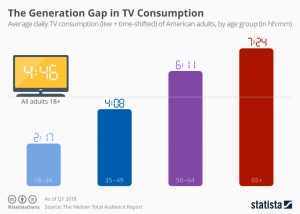According to Nielsen’s latest Total Audience Report, television is still the most used electronic medium for U.S. adults. On average, Americans aged 18 and older spend nearly five hours a day watching TV, easily beating the two hours and 20 minutes they interact with their smartphone on an average day.
While these findings certainly show that television is still relevant and shouldn’t be written off prematurely, a closer look reveals a trend that could spell doom for TV networks in the long run. According to Nielsen’s findings, there appears to be a generation gap in TV consumption. While those aged 50 and older spend more than six (ages 50-64) and seven hours (ages 65+) a day in front of the TV, young adults watch significantly less TV.
While some of this difference might be explained by the fact that many people over the age of 65 are retired and thus have more time to watch TV, the fact that younger people are more likely to use streaming services such as Netflix and Amazon Prime Video instead of watching “traditional” TV probably also plays a role in this. The latter is supported by findings from last year, which showed a gradual decline in TV consumption of 18 to 24-year-olds between 2011 and 2017.
source: statista

Ask me anything
Explore related questions





